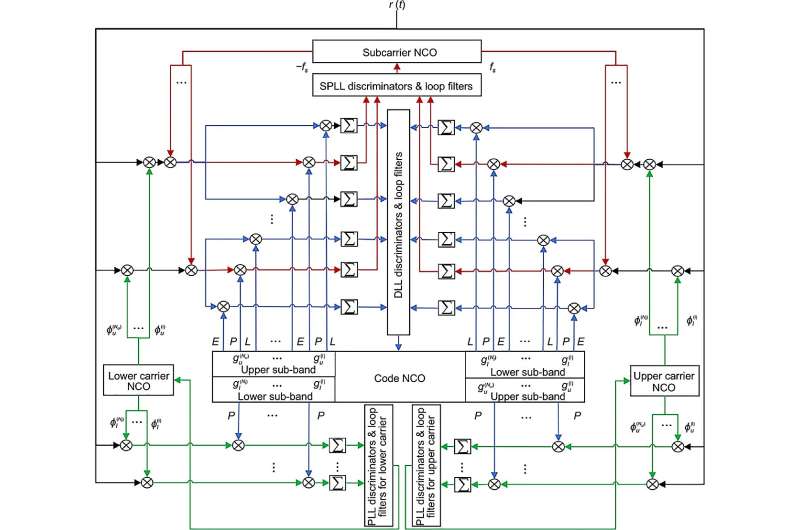Unlocking ultra-precision with cutting-edge tracking tech
Researchers have developed a Dual-assisted Multi-component Tracking (DMT) technique that significantly enhances the precision of Global Navigation Satellite Systems (GNSS). This innovation promises to enhance satellite navigation by leveraging wideband multiplexed signals for improved accuracy.
The evolution of Global Navigation Satellite Systems (GNSS) has led to the adoption of dual-frequency multiplexing techniques, which combine multiple signals into a single wideband multiplexed signal (WMS). Despite their potential for improving GNSS ranging precision, existing tracking methods have not fully capitalized on this advantage.
In a recently published study in Satellite Navigation, researchers from Tsinghua University have introduced a transformative Dual-assisted Multi-component Tracking (DMT) method, poised to redefine satellite navigation accuracy. By innovatively employing wideband multiplexed signals, the DMT technique leverages the full spectrum of GNSS signals more effectively than ever before.
Traditional GNSS tracking methods have struggled to harness the full potential of dual-frequency multiplexed signals, primarily used to improve signal robustness and accuracy. The DMT technique, developed by researchers at Tsinghua University, marks a significant advancement for WMS high-precision tracking by developing a comprehensive analysis method that extends the Root Mean Square Bandwidth (RMSB).
This approach takes full advantage of the spectrum separation and multi-component characteristics inherent in WMS, enabling more efficient use of signal components for tracking. By employing a dual-assisted structure, the DMT method enhances the tracking accuracy of both lower and upper sub-band components, leading to significant improvements in signal processing.
This includes reduced tracking jitters and increased ranging precision, essential for applications demanding high reliability and exactitude in positioning, navigation, and timing.
Dr. Zheng Yao, the study’s lead author from Tsinghua University, states, “Our Dual-assisted Multi-component Tracking technique represents a significant leap forward in satellite navigation technology. By fully utilizing the components of WMS, we achieve unparalleled tracking and ranging precision.”
The DMT technique revolutionizes GNSS accuracy, harnessing wideband signals to minimize tracking jitter and elevate ranging precision. This leap in satellite navigation benefits industries needing dependable, precise positioning and timing, setting a new standard for technological and industrial applications reliant on GNSS.
More information:
Yunhan Qi et al, Dual-assisted high-precision tracking technique for wideband multiplexed signals in new generation GNSS, Satellite Navigation (2024). DOI: 10.1186/s43020-023-00125-2
Provided by
Aerospace Information Research Institute, Chinese Academy of Sciences
Citation:
Next-gen satellite navigation: Unlocking ultra-precision with cutting-edge tracking tech (2024, March 13)
retrieved 17 March 2024
from https://techxplore.com/news/2024-03-gen-satellite-ultra-precision-edge.html
This document is subject to copyright. Apart from any fair dealing for the purpose of private study or research, no
part may be reproduced without the written permission. The content is provided for information purposes only.

Researchers have developed a Dual-assisted Multi-component Tracking (DMT) technique that significantly enhances the precision of Global Navigation Satellite Systems (GNSS). This innovation promises to enhance satellite navigation by leveraging wideband multiplexed signals for improved accuracy.
The evolution of Global Navigation Satellite Systems (GNSS) has led to the adoption of dual-frequency multiplexing techniques, which combine multiple signals into a single wideband multiplexed signal (WMS). Despite their potential for improving GNSS ranging precision, existing tracking methods have not fully capitalized on this advantage.
In a recently published study in Satellite Navigation, researchers from Tsinghua University have introduced a transformative Dual-assisted Multi-component Tracking (DMT) method, poised to redefine satellite navigation accuracy. By innovatively employing wideband multiplexed signals, the DMT technique leverages the full spectrum of GNSS signals more effectively than ever before.
Traditional GNSS tracking methods have struggled to harness the full potential of dual-frequency multiplexed signals, primarily used to improve signal robustness and accuracy. The DMT technique, developed by researchers at Tsinghua University, marks a significant advancement for WMS high-precision tracking by developing a comprehensive analysis method that extends the Root Mean Square Bandwidth (RMSB).
This approach takes full advantage of the spectrum separation and multi-component characteristics inherent in WMS, enabling more efficient use of signal components for tracking. By employing a dual-assisted structure, the DMT method enhances the tracking accuracy of both lower and upper sub-band components, leading to significant improvements in signal processing.
This includes reduced tracking jitters and increased ranging precision, essential for applications demanding high reliability and exactitude in positioning, navigation, and timing.
Dr. Zheng Yao, the study’s lead author from Tsinghua University, states, “Our Dual-assisted Multi-component Tracking technique represents a significant leap forward in satellite navigation technology. By fully utilizing the components of WMS, we achieve unparalleled tracking and ranging precision.”
The DMT technique revolutionizes GNSS accuracy, harnessing wideband signals to minimize tracking jitter and elevate ranging precision. This leap in satellite navigation benefits industries needing dependable, precise positioning and timing, setting a new standard for technological and industrial applications reliant on GNSS.
More information:
Yunhan Qi et al, Dual-assisted high-precision tracking technique for wideband multiplexed signals in new generation GNSS, Satellite Navigation (2024). DOI: 10.1186/s43020-023-00125-2
Provided by
Aerospace Information Research Institute, Chinese Academy of Sciences
Citation:
Next-gen satellite navigation: Unlocking ultra-precision with cutting-edge tracking tech (2024, March 13)
retrieved 17 March 2024
from https://techxplore.com/news/2024-03-gen-satellite-ultra-precision-edge.html
This document is subject to copyright. Apart from any fair dealing for the purpose of private study or research, no
part may be reproduced without the written permission. The content is provided for information purposes only.
